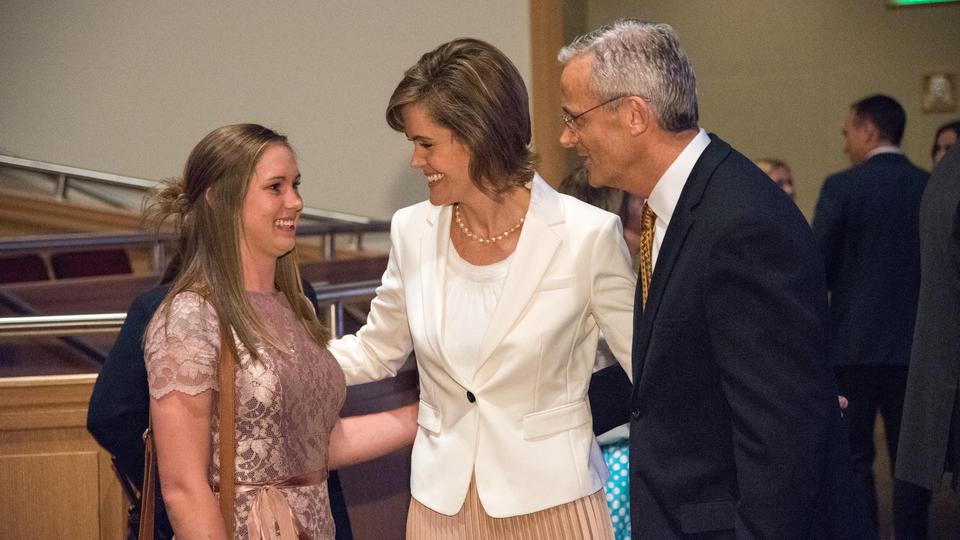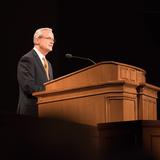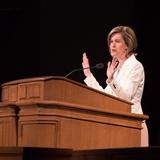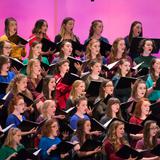As a teenager, Elder Patrick Kearon of the Presidency of the Seventy of The Church of Jesus Christ of Latter-day Saints said he was “deeply self-absorbed.” His perspective was changed, however, when a natural disaster struck the coast of England where he was attending boarding school. The English coastal area was known for bad weather, but a formidable storm blew in across the Irish Sea at hurricane force.
| Elder Patrick Kearon of the Presidency of the Seventy and his wife, Jennifer, visit with a woman on the campus of BYU–Idaho in Rexburg, Idaho, Sunday, May 6, 2018. The Kearons were there to speak at a worldwide devotional for young adults. 2018 by Intellectual Reserve, Inc. All rights reserved. | 1 / 7 |
Elder Kearon and his wife, Jennifer, spoke to young adults in a worldwide devotional originating from the campus of BYU–Idaho in Rexburg, Idaho, Sunday, May 6, 2018.
Continuing to describe his experience in the storm, he said extensive damage to thousands of homes was caused by flooding. As the storm calmed, the students at the boarding school were dispatched to help clean up. “What struck me next was the camaraderie that developed between those of us helping and those receiving help,” said Elder Kearon. “There was just a wonderful, good-natured feeling between people united in a worthy cause under challenging circumstances.”
That experience of serving others and enjoying it consumed Elder Kearon’s teenage thoughts and he wished they would last, but they didn’t.
The future Church leader was baptized a member of The Church of Jesus Christ of Latter-day Saints in his 20s, and shortly thereafter, he and Jennifer met while she was in London for six months studying art history and English literature. They married in the Oakland California Temple and returned to England for 19 years for work before his assignment came as a General Authority, requiring a move to Utah.
He recalled the message given by Church President Russell M. Nelson at the recent general conference about ministering the way Jesus Christ ministered.
“As I have reflected on what we were taught,” Elder Kearon said, “I know that if we heed this call to minister, we have the opportunity to rise out of ourselves; grow in faith, confidence, and happiness; and overcome our self-focus and the sense of emptiness and gloom which comes with it.
“The beauty of this kind of service, ministry, or discipleship is that it helps others in ways too numerous to list, but it also transforms us by taking us away from our worries, fears, anxieties, and doubts.”
In a message aimed at the young adults’ personal worth and God’s love for them, Sister Jennifer Kearon said, “Learning to find, feel, and understand our individual worth regardless of what other people might think or say about us is critical to our lifelong emotional and spiritual well-being. When we permit others’ words, actions, or opinions of us dictate how we feel about ourselves, we become fragile victims, never knowing when someone’s approval of us will turn to disdain.”
She said if we laid out our own life’s design, we would likely plan for happiness, success and relative ease, perhaps with a “smattering” of mild difficulties. “Who wants to experience failure, struggle, or any kind of loss or suffering? Who wants to do hard things?” she questioned.
Sister Kearon explained that if our self-worth was based solely on achievements, performance or visible perceived gifts, “we set ourselves up for failure and disappointment as soon as we don’t measure up and come out on top. But we’re not living self-designed lives of ease. We are living the lives God has planned for our maximum joy and progression.
“Rest assured,” she taught, “that the infinite and gentle love of God will invite you to make changes in your life through the experiences that come your way, both the bitter and the sweet. He will always invite change in a loving, encouraging, affirming way.”
Elder Kearon invited the young adults to pray today to know what they can do now and then continue to do so each morning. “When you see and feel the blessings this brings to you and to those you minister to, you will want to make this a daily pattern.”








